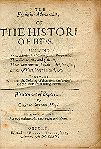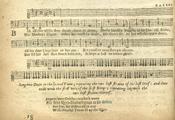
Title page
77 Kb (Jpeg)

Verso of title page
134 Kb (Jpeg)

Bee`s Madrigall
91 Kb (Jpeg)

Butler, Charles
The Feminin' Monarchi', or, The Histori of BEE'S (Third ed.)
Oxford, 1634.
Educated at Oxford, Charles Butler (c.1559-1647) was a philologist, clergyman, agriculturalist, and musical theorist. Although this is the third edition of his history of bees (the first appeared in 1609), it was the only one to have been printed in the peculiar orthography developed by the author. In his English Grammar (1633), Butler had proposed a spelling revision in which word appearances would match word sounds (see the second illustration for an example). The same scholar also published a book on music theory, Principles of Musik in Singing and Setting (1636), which he dedicated to Charles I. The eighteenth century historian Sir John Hawkins (General History of Music, II, 574) gave the treatise a positive recommendation: "[It is] a very learned, curious, and entertaining book … and may be considered as a judicious supplement to [Thomas] Morley's Introduction [1597]."
Butler also included music in his treatise on bees. Using a printing format common to Elizabethan madrigals, he set down in notation the music he heard the bees make in their after-swarm. According to the author, the Melissomelos (or Bee`s Madrigall) presents all the elements of music: rhythm, the tones of the hexachord, and the six harmonic concords. Butler also adds that
If any man dislike the harshness of the Seconds and Sevenths … he showeth himself no experienced Artist, which knoweth not that as well in Musik as Oeconomi, there must sometime be Discords: yea and that in either they have their laudable use: (as serving to make sweet Concords the sweeter).
Butler goes so far as to say that "if Musik were lost, it might be found with the Muses Birds". The third illustration is a transcription of the madrigal, with a description of its compositional style transcribed from Butler's writing.
|
Grace Doherty Library Centre College Danville, KY |
September 1, 1999 |